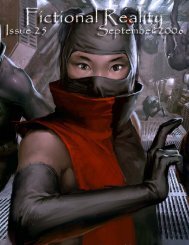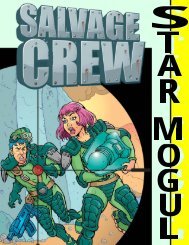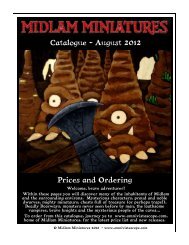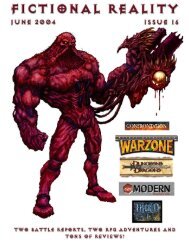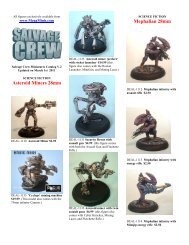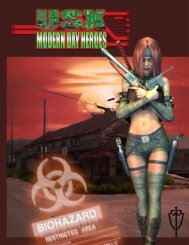from the editor - Mega Miniatures
from the editor - Mega Miniatures
from the editor - Mega Miniatures
Create successful ePaper yourself
Turn your PDF publications into a flip-book with our unique Google optimized e-Paper software.
BASICS<br />
“Habet, Hoc Habet!” is <strong>the</strong> phrase <strong>the</strong> roman crowds would shout when a<br />
gladiator fell in combat. Loosely translated it means, “ He’s down, he’s had<br />
it!” Habet, Hoc, Habet! (HHH!) is also a set of rules for recreating<br />
gladiatorial combat <strong>from</strong> ancient Rome using 25mm miniatures. The game is<br />
quick paced, bloody, and does a good job of capturing <strong>the</strong> “feel” (slightly<br />
tongue in cheek) of gladiatorial combat. The game is published by Flagship<br />
Games and can be purchased on-line for $20, or you can purchase a “Starter<br />
Deal” which includes <strong>the</strong> rules and a set of Foundry 28mm gladiator<br />
miniatures (enough for two people to start playing) for $35.<br />
INSIDE<br />
The HHH! rulebook is spiral bound, LXX pages long (that’s 70 pages for<br />
those not apt in roman numerals), and printed in black and white. The rules<br />
cover everything for man-to-man combat, man-to-animal combat, chariot<br />
racing, combat while racing chariots, and a fantasy version of Gladiator. The<br />
spiral binding makes it easier to backfold to keep it open to a useful page<br />
without damaging <strong>the</strong> book. The rules start with a Glossary that describes <strong>the</strong><br />
Roman terms used throughout <strong>the</strong> book; i.e. A samnite is a heavy gladiator<br />
who fought with a short sword called a gladius, a thraex is a gladiator who<br />
fought in light armor and a sharply angled sword called a sica, a tiros is a<br />
novice gladiator, a ludus is a gladiatorial training school, and most important a<br />
lanista is <strong>the</strong> owner of a troop of gladiators (<strong>the</strong> player takes on <strong>the</strong> role of <strong>the</strong><br />
lanista in HHH!).<br />
Next, <strong>the</strong> basics of <strong>the</strong> game are described. There are 4 levels of gladiators,<br />
which are <strong>from</strong> lowest to highest: Novice (tiro), Fighter, Warrior, and<br />
Champion (primus palus). Each level requires a certain number of experience<br />
points and gets a different number of actions a turn and will fatigues slower in<br />
combat. Each gladiator is also described <strong>the</strong>ir stats (Strength, Size, Health,<br />
Speed, Agility, Luck, and Popularity) and skills (Grappling, Dagger, Sword,<br />
etc…). The game mainly uses 10-sided dice, but 4, 6, 8, 12, and 20-sided dice<br />
are also need <strong>from</strong> time to time and a deck of regular playing cards are used as<br />
“action cards”. The combat turn is divided into <strong>the</strong> Initiative phase (action<br />
cards are dealt out), <strong>the</strong> Action phase (all action cards are played and actions<br />
are resolved), and <strong>the</strong> End phase (all gladiators who attacked this turn get an<br />
additional fatigue point).<br />
Each gladiator gets an action when <strong>the</strong>y play <strong>the</strong>ir action card. The action<br />
cards must be played in sequence with a King being played first down to 2<br />
being played last (<strong>the</strong> suit order is Spade-Heart-Club-Diamond). Aces and<br />
Jokers are kept in <strong>the</strong> deck. An Ace is a “ free” action that acts like an<br />
interrupt, even interrupting an action (except a die roll) in progress. A Joker<br />
allows a free re-roll that may be used for any die roll that turn, even if <strong>the</strong> die<br />
roll does not effect <strong>the</strong> player playing <strong>the</strong> Joker. If a player is dealt an Ace or<br />
Joker in <strong>the</strong> initiative phase <strong>the</strong>y get ano<strong>the</strong>r action card to “replace” <strong>the</strong> Ace<br />
or Joker.<br />
Gladiators gain fatigue counters for performing such action as running,<br />
sprinting, or charging. A fatigue counter is also earned each turn a gladiator<br />
attacks in melee, no matter how many times <strong>the</strong>y attack. Once a gladiator has<br />
earned five or more fatigue counters, <strong>the</strong>y must roll a die (a d8, d10, d12, or<br />
d20 depending on <strong>the</strong>ir level) greater than or equal to <strong>the</strong> number of fatigue<br />
counters before <strong>the</strong>y performing an action. If <strong>the</strong> gladiator fails <strong>the</strong> roll <strong>the</strong>n<br />
<strong>the</strong>y must rest for that action in which case <strong>the</strong>y loose 1 to 4 fatigue counters.<br />
73<br />
A combat action can be made when a model is within range of your weapon<br />
and in your front facing. Depending on <strong>the</strong> size of your HtH weapon, <strong>the</strong><br />
range can be anywhere <strong>from</strong> base-to-base contact or up to 2” away. If <strong>the</strong><br />
model is not in range, <strong>the</strong>n you have <strong>the</strong> option of charging, which is<br />
combining a running or sprinting action with a fighting action. The gladiator<br />
gets a bonus for charging, but also suffers a minus on <strong>the</strong>ir defenses until <strong>the</strong>ir<br />
next action which leaves <strong>the</strong>m open to a counter attack. This is a good time to<br />
pull out that Ace and get an immediate follow-up to your charge, preventing<br />
anyone <strong>from</strong> taking advantage of your weakened defenses. Close combat is<br />
resolved by rolling a modified 6 or better on a d10. If successful <strong>the</strong> defender<br />
also has a chance to parry by rolling a modified 6 or better on a d10. If <strong>the</strong><br />
parry is successful, <strong>the</strong>n <strong>the</strong> parrying weapon’s defense value is subtracted<br />
<strong>from</strong> any damage that <strong>the</strong> attack may cause before it is applied to <strong>the</strong> hit<br />
location. If any damage makes it past <strong>the</strong>y parry <strong>the</strong>n <strong>the</strong> hit location is rolled.<br />
If that location is protected by any armor <strong>the</strong>n <strong>the</strong> armor save is made (to see<br />
if <strong>the</strong> armor was hit in that location) and if successful <strong>the</strong>n <strong>the</strong> armor’s defense<br />
value is subtracted <strong>from</strong> <strong>the</strong> remaining damage before applying it to <strong>the</strong><br />
defending model. Ranged combat functions like close combat, except that <strong>the</strong><br />
range is measured after <strong>the</strong> attack is declared, and if <strong>the</strong> target is out of range<br />
<strong>the</strong> attack automatically misses. Crits and Fumbles happen in combat when<br />
an attack or parry rolls a natural 10 (for a Crit) or 1 (for a Fumble). They can<br />
be devastating with a critical doing maximum possible damage, damaging<br />
armor and parrying weapons in its path, and a fumble meaning that you could<br />
have done something stupid like slipping on a banana peal. The game is much<br />
more bloody because of Crits and Fumbles.<br />
CAMPAIGN GAME<br />
Expect a one-off game to last anywhere <strong>from</strong> 10 to 45 minutes. But this game<br />
was meant to be played as a campaign game, not as a single battle. When you<br />
are a lanista all you care about is <strong>the</strong> wealth and reputation of your ludis (<strong>the</strong><br />
gladiator school). While it might be disappointing that <strong>the</strong> newly trained<br />
gladiator is killed on his first battle, if he dies a spectacular death <strong>the</strong><br />
reputation of <strong>the</strong> ludis will increase!<br />
The campaign game starts off with between 4 to 8 lanista each starting off<br />
with <strong>the</strong> same amount of money which <strong>the</strong>y use later on to purchase one or<br />
more slaves. After this an Editor will be chosen for <strong>the</strong> month <strong>from</strong> among<br />
<strong>the</strong> lanista. It is <strong>the</strong> Editor’s responsibility to roll to determine what slaves are<br />
available for purchase that can be trained into gladiators determine what king<br />
of gladiatorial game will be held that month. The lanista select which<br />
gladiators will fight in <strong>the</strong> games and <strong>the</strong>n <strong>the</strong> games will be played. After <strong>the</strong><br />
games <strong>the</strong> players determine what happed to <strong>the</strong> wounded gladiators, calculate<br />
<strong>the</strong>ir experience and Popularity. They <strong>the</strong>n spend experience to improve <strong>the</strong><br />
gladiator’s stats or skills and can train any gladiators who did not participate<br />
in this month’s games. The ludis will use any money gained <strong>from</strong> <strong>the</strong> games<br />
to maintain <strong>the</strong>ir ludis and purchase and train new gladiators (always a<br />
necessity since you always seem to be loosing <strong>the</strong>m).<br />
VARIANTS<br />
HHH! also contains rules for chariot racing, mounted combat, and beasts. The<br />
beast rules are used for special campaign events called venatio which pits<br />
against beast in combat. The beasts could be lions, bears, wild boars (<strong>the</strong><br />
dangerous beasts) or zebras, giraffes, elephants (classified as “ harmless” but<br />
can still do a lot of damage, expecially if injured) The rules not only contain<br />
<strong>the</strong> characteristics and skills for various beasts, but an action chart which<br />
makes fighting a beast a bit more unpredictable and seemingly realistic.<br />
CONCLUSION<br />
If you are looking for a fun, easy to play, and fast paced game for 4 to eight<br />
players, <strong>the</strong>n “ Habet, Hoc Habet!” is a great choice. I recommend spending<br />
<strong>the</strong> $35 for a rulebook<br />
and 6 miniatures,<br />
playing a few single<br />
combats to get <strong>the</strong> feel<br />
for <strong>the</strong> mechanics and<br />
<strong>the</strong>n start a campaign<br />
with at least 4 people.



